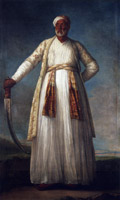 Mohammed Dervisch-Khan(1787), from Letter IV of Vigée Le Brun's memoirs: |
"When I arrived at their apartment, one of them brought in some rose water and sprinkled it on my hands; then the larger of the two, whose name was Davich Khan, sat for me. I painted him standing, his hand on his dagger. I painted everything, his dress, his hands, exactly as they were, such was his accommodating nature. I let the painting dry in another room and started drawing the old ambassador who sat with his son beside him. The father had a particularly splendid head. They were both dressed in gowns of white muslin, embroidered with gold flowers; these robes, a kind of tunic with large sleeves folded back at the cuff, were fastened at the waist with richly decorated belts. Except for the hems of their costumes and the background, I completely finished this painting at their home." "I had told Mme Bonneuil about these sessions and she was very keen to meet the ambassadors. They invited us both to dinner and we accepted from sheer curiosity. When we walked into the dining room we were rather taken aback to see that the dinner was served on the floor. We obviously felt obliged to follow their custom and found ourselves almost lying around the table. They served us with their hands, taking the food from various dishes, one of which contained a fricassée made from sheep's feet, served in a spicy white sauce, while another was a sort of stew. I'm sorry to say that we had a miserable time; we found the sight of those bronze hands being used as serving spoons too repellent. They had brought with them a young man who spoke a little French. During the meeting, Mme Bonneuil taught him to sing Annette à l'âge de quinze ans. When the time came to say goodnight, he sang his song and showed his regret at our parting by saying, 'Ah, how my heart weeps!' I thought this typically oriental and very prettily phrased." "When the portrait of Davich Khan was dry, I asked him to bring it for me to see, but he had hidden it behind his bed and did not want to give it to me, saying that the portrait needed a soul..." "It was not possible to reclaim my painting without the use of subterfuge. When the ambassador realised that it had gone, he sent for his valet, intending to kill him. The interpreter had a very difficult task persuading him that killing one's valet was just not done in Paris. He was also forced to tell him that the portrait had been requested by the King of France. These two paintings were exhibited at the salon of 1789. After the death of M. Le Brun, who always took possession of my work, they were sold, and I have no idea who owns them today." (note1) A footnote reads: "tipu-Saïb, the Sultan of Maïssour [sic, Mysore], was born in 1749 and killed by an English musket ball on May 4, 1799 in Seringapatam. He had sent an ambassador to France in 1787 with the task of concluding an offensive and defensive alliance with the King, Louis XVI, and to ask him for his help against the English whom he wished to chase out of India. His mission was not successful so tipu-Saïb brought his ambassadors back and avenged their failure by having them beheaded as soon as they returned to Maïssour." The son, apparently shown in this image, was Mohammed Dervisch-Khan, and the painting is in the Marnier-Lapostolle collection, France. The location of the painting of the father, Mohammed Usman-Khan, is unknown.
Painting information: oil on canvas, Marnier-Lapostolle Collection, France |
|
Vigée Le Brun's Home Page | Special Galleries |
